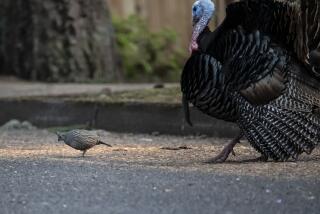Condor Chick Is Found Dead in Forest
- Share via
In a major blow to the $35-million effort to save North America’s largest bird, the first California condor chick brooded and hatched in the wild in 18 years was found dead Friday on a remote ledge deep in Los Padres National Forest.
The 6-month-old fledgling was missing for the last two days, but biologists hoped it was merely off testing its wings. Hopes were dashed when the bird was found just below the sandstone cave where it hatched in April.
The cause of death is unknown, and the condor will be sent to the San Diego Zoo for an autopsy. There are two remaining chicks in the refuge, which is near Fillmore.
Meanwhile, the bird’s father has been missing for almost three weeks and is presumed dead.
Biologists say they last received a radio transmission from the 8-year-old adult Sept. 19, when it was near Lion Canyon in rural Santa Barbara County.
The transmitter on the bird’s wing stopped sending signals, and officials suspect the condor either died from lead poisoning or by gunfire.
If it was lead poisoning, the adult could have passed it on to the chick when feeding it, biologists said.
The chick’s hatching was hailed as a watershed event, a validation of a controversial captive-breeding program that boosted condor numbers from 15 to almost 200 over the last 20 years. The chick would have been the first in a new generation of wild condors soaring the skies from Baja California to Big Sur.
But while condors have been decapitated by power lines, poisoned by antifreeze and pecked to death by other condors, this fatality may be the hardest to take.
“We are all pretty distraught,” said Bruce Palmer, coordinator of the condor project for the U.S. Fish and Wildlife Service. “Any number of things could have happened. Whether there was a connection between the chick’s death and the male, we don’t know. There was no obvious cause of death when it was discovered.”
Palmer visited the isolated region of sandstone pinnacles in the Sespe Condor Refuge hoping to watch the chick first leave the nest. But he believes he was a day late. Biologists say young condors learning to fly will often do a sort of controlled crash landing into a tree or bush and wait for days before leaving.
“I felt personally attached to it,” Palmer said.
But while the loss of two birds was a tragedy, Palmer said it wasn’t a setback for the program, which will be releasing three condors in Baja California on Wednesday and has refuges in Big Sur, Los Padres and the Vermilion Cliffs near the Grand Canyon. There are 73 condors in the wild and 132 in captivity. The goal is for two populations of 150 each with 15 breeding pairs in California and Arizona.
“I don’t think there is a greater impact, it’s more of a personal disappointment,” Palmer said. “Fledgling mortality is greatest when they leave the nest. It could have encountered coyotes or golden eagles.”
Palmer said an investigation will be done to review program practices and to see if the bird was malnourished or suffered from lead poisoning.
Mike Wallace, condor recovery team leader, said both mother and father were feeding the chick so it didn’t starve. He said the father may have regurgitated lead pellets or bullets while feeding the chick.
“If it turns out to be lead poisoning, we will move one step further on this,” Wallace said. “If we find we are losing an abnormally high number of birds because of lead poisoning or anything else, we have the moral responsibility to mitigate that.”
U.S. Fish and Wildlife advocates the creation and use of non-lead bullets and urges hunters to bury the gut piles of animals they shoot with lead bullets. Yet they don’t want to instigate a fight with hunters or the National Rifle Assn.
“They are applying a Band-Aid and not treating the disease,” said David Clendenen, a critic of the condor program and former lead biologist for the Fish and Wildlife Service at Hopper Mountain National Wildlife Refuge. “Fish and Wildlife is not confronting the lead issue at all. All you hear about is how successful they are, but they don’t have anything near a self-sustaining population of birds.”
Wallace agrees that lead could doom the birds. But he thinks high numbers increase the birds’ chances of survival.
“Emotionally, you can’t escape the fact that we all got really jazzed about this bird, and to this point it has been a huge success story,” Wallace said. “And to have the first chick in the wild die is an emotional blow.”
Janet Hamber has weathered death and disappointment during her 26 years as a condor biologist.
She watched chicks swept off nests by winds. She was there when six condors, considered the best hope for breeding, vanished without a trace. And she saw a chick accidentally killed by a fellow biologist.
“The ups and downs are huge,” she said. “But if we don’t try, then we’ll never succeed at anything.”
More to Read
Sign up for Essential California
The most important California stories and recommendations in your inbox every morning.
You may occasionally receive promotional content from the Los Angeles Times.










